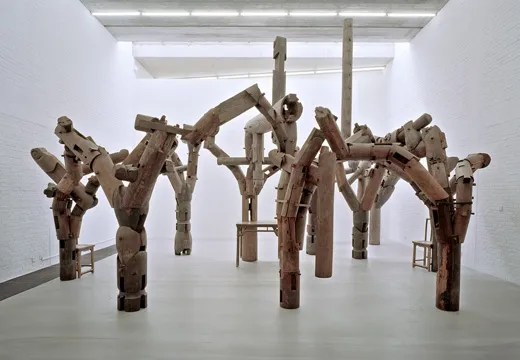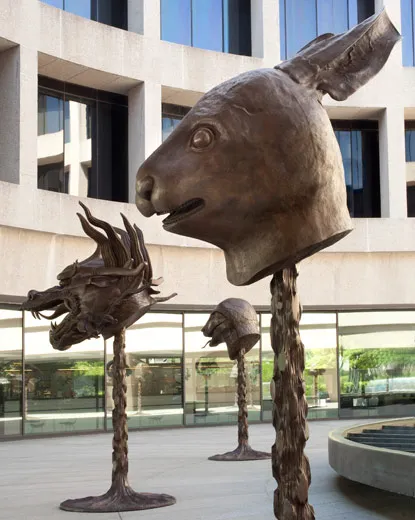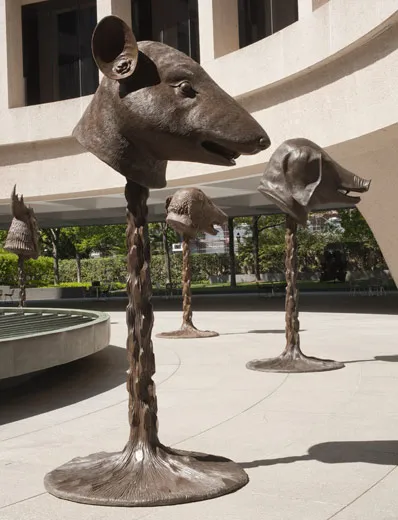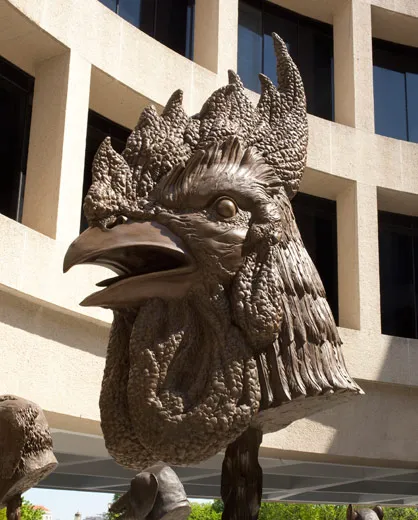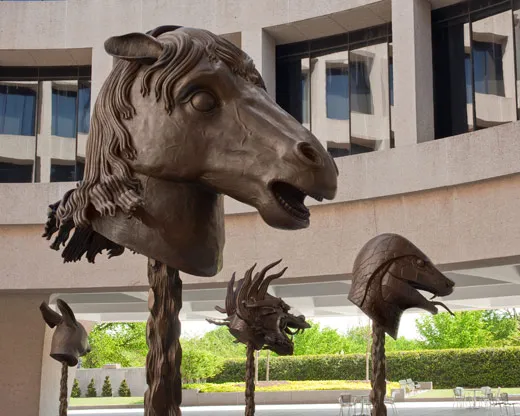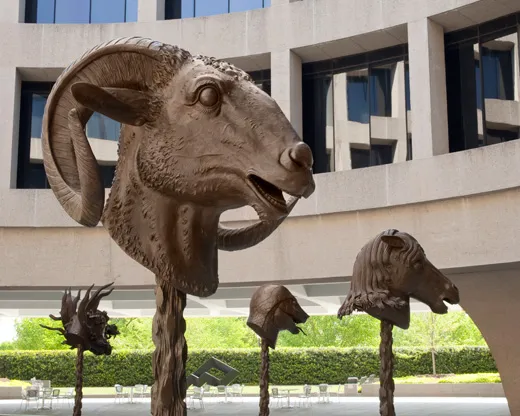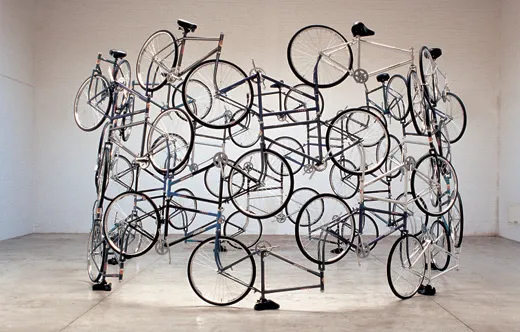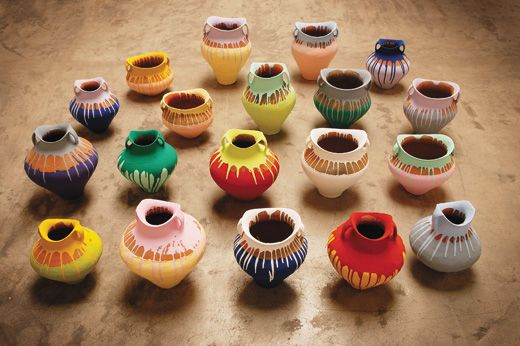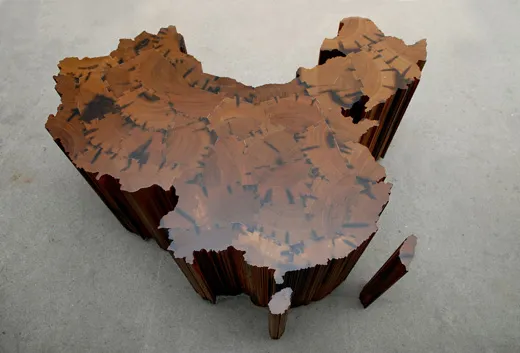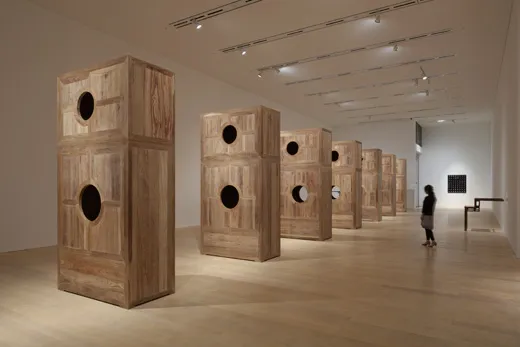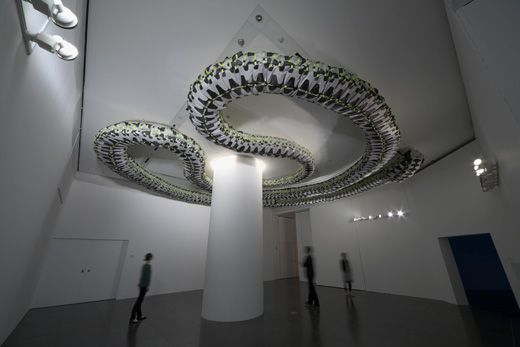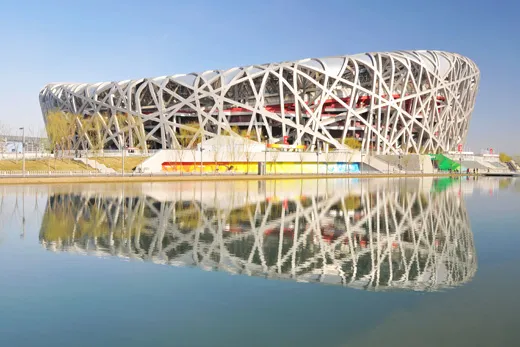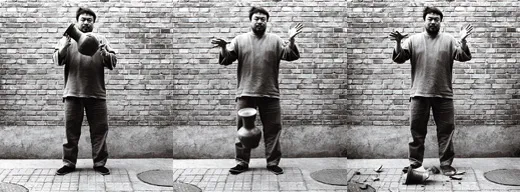Is Ai Weiwei China’s Most Dangerous Man?
Arrested and harassed by the Chinese government, artist Ai Weiwei makes daring works unlike anything the world has ever seen
/https://tf-cmsv2-smithsonianmag-media.s3.amazonaws.com/filer/Ai-Weiwei-portrait-631.jpg)
Last year, the editors of ArtReview magazine named the Chinese dissident Ai Weiwei the most powerful artist in the world. It was an unusual choice. Ai’s varied, scattershot work doesn’t fetch the highest prices at auction, and critics, while they admire his achievement, don’t treat him as a master who has transformed the art of his period. In China, Ai—a brave and unrelenting critic of the authoritarian regime—has spent time in jail, was not allowed by the government to leave Beijing for a year and cannot travel without official permission. As a result, he has become a symbol of the struggle for human rights in China, but not preeminently so. He is too quixotic a figure to have developed the moral gravitas of the great men of conscience who challenged the totalitarian regimes of the 20th century.
So what is it about Ai? What makes him, in Western eyes, the world’s “most powerful artist”? The answer lies in the West itself. Now obsessed with China, the West would surely invent Ai if he didn’t already exist. China may after all become the most powerful nation in the world. It must therefore have an artist of comparable consequence to hold up a mirror both to China’s failings and its potential. Ai (his name is pronounced eye way-way) is perfect for the part. Having spent his formative years as an artist in New York in the 1980s, when Warhol was a god and conceptual and performance art were dominant, he knows how to combine his life and art into a daring and politically charged performance that helps define how we see modern China. He’ll use any medium or genre—sculpture, ready-mades, photography, performance, architecture, tweets and blogs—to deliver his pungent message.
Ai’s persona—which, as with Warhol’s, is inseparable from his art—draws power from the contradictory roles that artists perform in modern culture. The loftiest are those of martyr, preacher and conscience. Not only has Ai been harassed and jailed, he has also continually called the Chinese regime to account; he has made a list, for example, that includes the name of each of the more than 5,000 schoolchildren who died during the Sichuan earthquake of 2008 because of shoddy schoolhouse construction. At the same time, he plays a decidedly unsaintly, Dada-inspired role—the bad boy provocateur who outrages stuffed shirts everywhere. (In one of his best-known photographs, he gives the White House the finger.) Not least, he is a kind of visionary showman. He cultivates the press, arouses comment and creates spectacles. His signature work, Sunflower Seeds—a work of hallucinatory intensity that was a sensation at the Tate Modern in London in 2010—consists of 100 million pieces of porcelain, each painted by one of 1,600 Chinese craftsmen to resemble a sunflower seed. As Andy would say, in high deadpan, “Wow.”
This year Ai is the subject of two shows in Washington, D.C., an appropriate backdrop for an A-list power artist. In the spring, “Perspectives: Ai Weiwei” opened at the Arthur M. Sackler Gallery with a monumental installation of Fragments (2005). Working with a team of skilled carpenters, Ai turned ironwood salvaged from dismantled Qing-era temples into a handsomely constructed structure that appears chaotic on the ground but, if seen from above, coalesces into a map of China. (Fragments embodies a dilemma characteristic of Ai: Can the timber of the past, foolishly discarded by the present, be recrafted into a China, perhaps a better China, that we cannot yet discern?) And the Hirshhorn Museum and Sculpture Garden will present a wide-ranging survey of Ai’s work, from October 7 to February 2013. The exhibition title—“According to What?”—was borrowed from a Jasper Johns painting.
The question that is not often asked is whether Ai, as an artist, is more than just a contemporary phenom. Is Sunflower Seeds, for example, more than a passing headline? Will Ai ultimately matter to China—and to the future—as much as he does to today’s Western art world?
Ai lives in Caochangdi, a village in suburban Beijing favored by artists, where, like an art-king in exile, he regularly greets visitors come to pay homage to his vision of a better China. A large, burly man with a fondness for the neighborhood’s feral cats, Ai, who is 55, is disarmingly modest for one who spends so much time in the public eye. He recently told Christina Larson, an American writer in Beijing who interviewed the artist for Smithsonian, that he remains astonished by his prominence. “The secret police told me everybody can see it but you, that you’re so influential. But I think [their behavior] makes me more influential. They create me rather than solve the problems I raise.”
The authorities keep him in the news by, for example, hounding him for tax evasion. This past summer, during a hearing on his tax case—which he was not allowed to attend—his studio was surrounded by about 30 police cars. The story was widely covered. In 2010, he established a studio in a proposed arts district in Shanghai. The regime, fearing it would become a center of dissent—and claiming the structure violated a building code—destroyed it early in 2011. According to Ai, “It made every young person who may or may not have liked me before think I must be some kind of hero.”
Ai lives well enough, even under house arrest, but there’s little about him that’s extravagant or arty. His house, like many in the district, is gray and utilitarian. The neighborhood doesn’t have much street or café life; it’s the sort of place, one Beijing resident said, where people go to be left alone. His courtyard home consists of two buildings: a studio and a residence. The studio—a large space with a skylight—has a gray floor and white walls and seems much less cluttered than other artist studios. Both the studio and the residence have a neutral air, as if they have not yet been filled, but are instead environments where an artist waits for ideas, or acts on impulse, or greets cats and visitors. Like Andy Warhol, Ai always has a camera at hand—in his case, an iPhone—as if he were waiting for something to happen.
His life seems steeped in “befores” and “afters.” Before the modern era, he says, China’s culture had a kind of “total condition, with philosophy, aesthetics, moral understanding and craftsmanship.” In ancient China, art could become very powerful. “It’s not just a decoration or one idea, but rather a total high model which art can carry out.” He finds a similar and transcendent unity of vision in the work of one of his favorite artists, van Gogh: “The art was a belief that expressed his views of the universe, how it should be.”
His more immediate before, however, is not ancient China but the totalitarian culture into which he was born. Ai’s father, the renowned poet Ai Qing, ran afoul of the regime in the late ’50s and he and his family were sent to a labor camp. He spent five years cleaning toilets. (Ai Qing was exonerated in 1978 and lived in Beijing until his death in 1996.) To Ai Weiwei, there was also another, less personal kind of emptiness about the China of before. “There were almost no cars on the street,” he said. “No private cars, only embassy cars. You could walk in the middle of the street. It was very slow, very quiet and very gray. There were not so many expressions on human faces. After the Cultural Revolution, muscles were still not built up to laugh or show emotion. When you saw a little bit of color—like a yellow umbrella in the rain—it was quite shocking. The society was all gray, and a little bit blue.”
In 1981, when it became possible for Chinese citizens to travel abroad, Ai made his way to New York. His first glimpse of the city came on a plane in the early evening. “It looked like a bowl of diamonds,” he said. It was not the city’s material wealth that attracted him, however, but its dazzling freedom of action and speech. For a time Ai had an apartment near Tompkins Square Park in the East Village, where young Chinese artists and intellectuals often gathered. But he had no particular success as an artist. He worked odd jobs and spent his time going to exhibitions. The poet Allen Ginsberg, whom he befriended, told Ai that galleries would not take much notice of his work.
Although he has a special interest in Jasper Johns, Warhol and Dada, Ai is not easily categorized. He has a wandering mind that can embrace very different, sometimes contrary, elements. The same artist who loves the transcendental oneness of van Gogh, for example, also admires the abstruse and sometimes analytical sensibility of Johns. Much of Ai’s best-known work is rooted in conceptual and Dadaist art. He has often created “ready-mades”—objects taken from the world that an artist then alters or modifies—that have a strong satirical element. In one well-known example, he placed a Chinese figurine inside a bottle of Johnnie Walker Scotch. Yet in contrast to many conceptual artists, he also demonstrated, early on, a keen interest in a work’s visual qualities and sent himself to study at the Parsons School of Design and the Art Students League in New York.
Ai’s interest in design and architecture led him, in 2006, to collaborate with HHF Architects on a country house in upstate New York for two young art collectors. The house is four equal-sized boxes covered on the outside in corrugated metal; the small spaces between the boxes permit light to suffuse the interior, where the geometry is also softened by wood and surprising angles. The award-winning design is both remarkably simple and—in its use of light and the grouping of interior spaces—richly complex.
But Ai’s interest in design and architecture has less to do with being a conventional architect than with rebuilding—and redesigning—China itself. Returning to China in 1993, when his father fell ill, he was discouraged by two new forms of oppression: fashion and cronyism. “Deng Xiaoping encouraged people to get rich,” he said, adding that those who succeeded did so through their affiliation with the Communist Party. “I could see so many luxury cars, but there was no justice or fairness in this society. Far from it.” New consumer goods such as tape recorders brought fresh voices and music into a moribund culture. But rather than struggle to create independent identities, Ai said, young people instead settled into a new, easy and fashion-driven conformity. “People listened to sentimental Taiwanese pop music. Levi’s blue jeans came in very early. People were seeking to be identified with a certain kind of style, which saves a lot of talking.”
Ai responded to the new China with scabrous satire, challenging its puritanical and conformist character by regularly showcasing a rude and boisterous individuality. He published a photograph of himself in which he is shown naked, leaping ludicrously into the air, while holding something over his genitals. The photo caption—“Grass mud horse covering the middle”—sounds in spoken Chinese like a coarse jest about mothers and the Central Committee. He formed a corporation called “Beijing Fake Cultural Development Ltd.” He mocked the Olympic Games, which, in China, are now a kind of state religion. The CCTV tower in Beijing, designed by the celebrated Dutch architect Rem Koolhaas, is regarded with great national pride; the Chinese were horrified when a fire swept through an annex and a nearby hotel during construction. Ai’s response? “I think if the CCTV building really burns down it would be the modern landmark of Beijing. It can represent a huge empire of ambition burning down.”
Ai’s resistance to all forms of control—capitalist and communist—manifests itself in one poignant way. He refuses to listen to music. He associates music with the propaganda of the old days and prefers the silent spaces of independent thought. “When I was growing up, we were forced to listen to only Communist music. I think that left a bad impression. I have many musician friends, but I never listen to music.” He blames the Chinese educational system for failing to generate any grand or open-ended sense of possibility either for individuals or the society as a whole. “Education should teach you to think, but they just want to control everyone’s mind.” What the regime is most afraid of, he says, is “free discussion.”
Ai will occasionally say something optimistic. Perhaps the Internet will open up the discussion that schools now restrain, for example, even if the blog he ran has been shut down. For the most part, though, Ai’s commentary remains bleak and denunciatory. Few people in China believe in what they are doing, he says, not even the secret police. “I’ve been interrogated by over eight people, and they all told me, ‘This is our job.’...They do not believe anything. But they tell me, ‘You can never win this war.’”
Not soon anyway. In the West, the artist as provocateur—Marcel Duchamp, Warhol and Damien Hirst are well-known examples—is a familiar figure. In a China just emerging as a world power, where the political authorities prize conformity, discipline and the accumulation of riches, an artist working in the provocative Western tradition is still regarded as a threat. Chinese intellectuals may support him, but the Chinese generally have no more understanding of Ai than a typical American has of Duchamp or Warhol. “There are no heroes in modern China,” Ai said.
The West would like to turn Ai into a hero, but he seems reluctant to oblige. He lived in postmodern New York. He knows the celebrity racket and the hero racket. “I don’t believe that much in my own answer,” he said. “My resistance is a symbolic gesture.” But Ai, if not a hero, has found ways to symbolize certain qualities that China may one day celebrate him for protecting and asserting. Free discussion is one. An out-there, dark and Rabelaisian playfulness is another. But the most interesting quality of them all is found in his best works of art: a prophetic dream of China.
Much of Ai’s art is of only passing interest. Like so much conceptual art, it seems little more than a diagram of some pre-conceived moral. Art with a moral too often ends with the moral, which can stopper the imagination. Consider Ai’s amusing and well-known Johnnie Walker piece. Is it suggesting that China is enveloped within—and intoxicated by—Western consumer culture? Of course it is. Once you’ve seen it, you don’t have to think about it anymore. Jokes, even serious jokes, are like that. They’re not as good the second time around.
But several Ai works are fundamentally different in character. They’re made of more than morals and commentary. They’re open-ended, mysterious, sometimes utopian in spirit. Each calls to mind—as architecture and design can—the birth of the new. The oddest instance is the “Bird’s Nest” stadium of the 2008 Olympics. While an impassioned critic of the propaganda around the Olympics, Ai nonetheless collaborated with the architects Herzog & de Meuron in the design of the stadium. What kind of China is being nurtured, one wonders, in that spiky nest?
According to Ai, governments cannot hide forever from what he calls “principles” and “the true argument.” He decries the loss of religion, aesthetic feeling and moral judgment, arguing that “this is a large space that needs to be occupied.” To occupy that space, Ai continues to dream of social transformation, and he devises actions and works that evoke worlds of possibility. For the 2007 Documenta—a famous exhibition of contemporary art held every five years in Kassel, Germany—Ai contributed two pieces. One was a monumental sculpture called Template, a chaotic Babel of doors and windows from ruined Ming and Qing dynasty houses. These doors and windows from the past seemed to lead nowhere until, oddly enough, a storm knocked down the sculpture. His second contribution was a work of “social sculpture” called Fairytale, for which he brought 1,001 people from China—chosen through an open blog invitation—to Documenta. He designed their clothes, luggage and a place for them to stay. But he did not point them in any particular direction. On this unlikely trip through the woods, the Chinese pilgrims might find for themselves a new and magical world. They too might discover, as Ai did when he went to New York, “a bowl of diamonds.”
Sunflower Seeds, his most celebrated work, yields similar questions. The painting of so many individual seeds is a slightly mad tour de force. But the scale of the work, which is at once tiny and vast—raindrop and ocean—seems no crazier than a “Made in China” consumer society and its bottomless desires. Does the number of seeds reflect the dizzying amount of money—millions, billions, trillions—that corporations and nations generate? Do the seeds simultaneously suggest the famines that mark Chinese history? Do they evoke China’s brief moment of cultural freedom in 1956 known as the “Hundred Flowers Campaign?” Do they represent both the citizen and the nation, the individual and the mass, endowing both with an air of germinating possibility? Will China ever bloom, one wonders, with the joyful intensity of van Gogh’s sunflowers?
Christina Larson in Beijing contributed reporting to this story.
